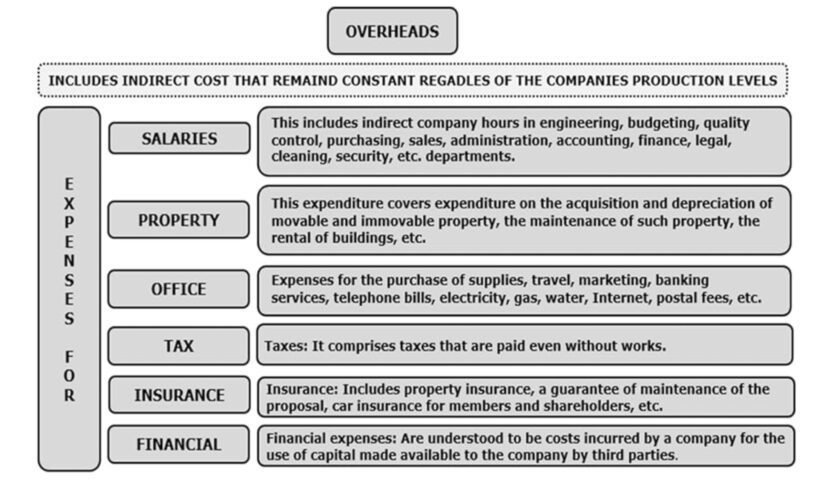 How to Calculate Overhead Costs in Construction Projects. Overhead Calculation Guide. Learn how to calculate and reduce overhead costs on construction projects. This comprehensive guide covers what overhead is and how to accurately estimate it.
How to Calculate Overhead Costs in Construction Projects. Overhead Calculation Guide. Learn how to calculate and reduce overhead costs on construction projects. This comprehensive guide covers what overhead is and how to accurately estimate it.
Identify and calculate overhead costs to set profitable project rates. Learn how accurately estimating overhead costs impacts budgeting and ensures business profitability.
Understand the sources of your overhead costs
Overhead Calculation: By evaluating the following four items, construction companies determine the overhead costs of their projects:
First, consider all technical, administrative, and maintenance (nonconstruction) salaries
Examples: Includes indirect hours of company engineering, budgeting, quality control, purchasing, sales, administration, accounting, finance, legal, janitorial, security, etc.
The image shows the author’s summary of typical general construction and/or installation costs.

Expenditures for movable and immovable assets (except for construction projects) are then included
Examples: This expenditure includes the purchase and depreciation of movable and immovable property, the maintenance of such property and the rental of buildings, etc.
Include also office expenses (excl. construction projects)
Examples: Expenses for purchasing supplies, travel, marketing, banking, telephone bills, electricity, gas, water, internet, postage, etc.
Finally, taxes, insurance, and financial costs (except for construction projects) are included
- Taxes: This includes taxes payable even without employment.
- Insurance, Examples: Include property insurance, proposal maintenance coverage, car insurance for members and shareholders, etc.
- Financial costs, Examples: Financial expenses refer to the costs incurred by a company for utilizing capital provided by third parties.
FAQs:
What is the best way to estimate the overhead costs in a small construction company?
Firstly, we can use the four elements above to produce a comprehensive list of our overheads over a given period.
The result gives us the historical overheads of the construction company.
How can I assign overhead to a new project?
Depending on the type of work performed by the contractor, it may be distributed as follows:
- Allocate overhead costs based on the number of direct labor hours for each project.
- Allocate indirect costs based on the material costs of each project.
- Allocate indirect costs, according to the square meters of the project.
- Assign overhead costs as a percentage of the direct costs incurred for each project.
What is the percentage of overhead for a construction company over a period of time?
To calculate the overhead percentage, divide the total overhead by the total sales for the period and multiply by 100.
The overhead cost formula is:

This percentage is the amount that the estimator will use to allocate the overhead costs to the new budgets.
On average, the overhead costs of construction can range from 5 percent to 15 percent of the direct costs.
However, it is important to note that the actual percentage of overhead costs can vary significantly between different contractors and projects. It is essential that contractors carefully analyze and manage their overhead costs to ensure profitability and competitiveness.
How to reduce overhead costs? / How to calculate overhead on construction projects
The reduction of overhead costs is a critical aspect for construction companies to remain competitive and to increase their profit margins.
Here are a few specific ways in which this can be achieved in the construction industry.
Firstly, use common sense
Overhead reduction. By using common sense, we can achieve an optimal level of total spend.
Reducing overhead costs to the bare minimum is a critical step in maintaining the company’s financial health.
Rent your office space
At the beginning of any business venture, it is advisable to operate with a minimum of overhead costs until the income justifies a larger investment.
Regular financial analysis
Identify areas of high overhead and implement strategies for improvement through regular financial analysis.
Bid realistically
Be realistic in your bidding process to avoid underestimating the cost of the project and running into financial problems during the project.
Adoption of technology
Reduce overhead by using construction management software and digital tools to streamline processes, minimize paperwork, and improve communication.
Work productivity
Monitor labor productivity and identify areas for improvement to complete tasks more efficiently.
Training of employees
Make sure your employees are well-trained and skilled. This minimizes errors, rework, and accidents. Well-trained employees work more efficiently.
Expenses for the office
Look for ways to reduce costs associated with the office, such as paper usage, printing costs, and office supplies.
Benchmarking
Compare your overhead costs to industry benchmarks. Identify areas where your costs may be higher than average and take action to improve them.
By implementing these strategies and reviewing their overall costs on a regular basis, construction companies can streamline their operations, improve their profitability, and remain competitive in the industry.
Note:
Some companies take risks by reducing the amount allocated to overhead in a budget in order to present a more competitive offer.
This occurs when the depreciation cost of heavy machinery used in construction is reduced or lowered, for instance.
Overhead costing in construction projects / Calculate man-hours
